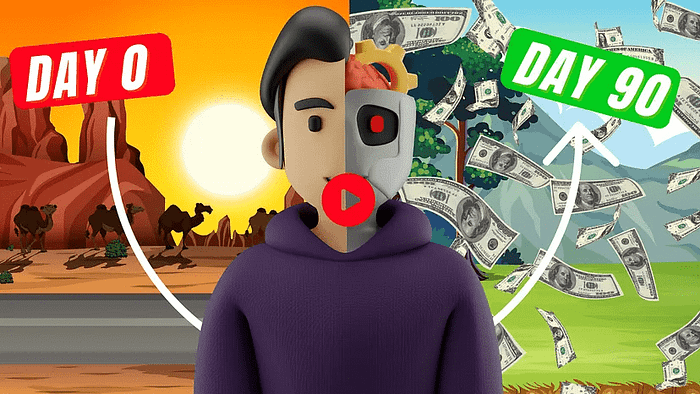13 Ways to Legally Destroy Your Competition and Dominate Your Market
In the cutthroat business world, learning how to legally destroy your competition is essential for long-term success. This comprehensive guide will explore 13 powerful strategies to outperform your rivals and establish market dominance.
We strongly recommend that you check out our guide on how to take advantage of AI in today’s passive income economy.
Table of Contents
Introduction
Imagine standing atop the business mountain, surveying the landscape below as your competitors struggle to keep up. This isn’t just a dream – it’s a reality for those who master the art of legally crushing their competition.
In this article, we’ll dive deep into 13 game-changing tactics that will help you destroy your competition and cement your place as an industry leader. From leveraging network effects to innovative pricing strategies, we’ll cover it all.
So, buckle up and get ready to transform your business into an unstoppable force. Let’s explore how you can legally annihilate your competition and build an empire that stands the test of time.
1. Harness the Power of Network Effects
Network effects are a potent weapon in your arsenal to destroy your competition. This strategy revolves around creating a product or service that becomes more valuable as more people use it.
Customer Base Network Effects
One type of network effect focuses on building a large, established user base. As your customer base grows, it naturally attracts more users, creating a snowball effect.
For example, social media platforms like Facebook leverage this type of network effect. The more users join the platform, the more valuable it becomes for everyone involved. This makes it incredibly difficult for competitors to break into the market and challenge your dominance.
Product Ecosystem Network Effects
Another powerful way to destroy your competition is by creating a closed-loop product ecosystem. Apple is a master of this strategy.
By developing unique plugs, software, and operating systems that only work with Apple products, they’ve created a seamless ecosystem that keeps users locked in. Once a customer buys one Apple product, they’re incentivized to purchase others, making it challenging for competitors to lure them away.
To implement this strategy in your business, consider how you can create interconnected products or services that work best together. This approach not only helps retain customers but also makes it extremely difficult for your competition to replicate your offering.
2. Secure Exclusive Control Over Resources or Technology
Gaining exclusive control over essential resources or technology is another effective way to destroy your competition. This strategy can be implemented in two main ways:
Resource Control
Possessing exclusive rights to crucial materials or resources gives you a significant advantage over your competitors. The DeBeers Group, for instance, has historically controlled a large portion of the diamond market.
By owning most of the mines and distribution channels, DeBeers can effectively control supply and demand, setting prices as they see fit. This level of control makes it nearly impossible for new competitors to enter the market and challenge their dominance.
Technological Superiority
In the tech world, having proprietary technology or vast amounts of data that others can’t legally replicate creates a substantial barrier to entry. Google’s search algorithm is a prime example of this.
Google’s years of data collection and algorithm refinements give them an edge that new competitors simply can’t match. Even with the rise of AI-powered search engines, Google’s vast data sets and technological prowess allow them to maintain their market leadership.
To apply this strategy, focus on developing unique technologies or accumulating valuable data that your competitors can’t easily replicate. This could involve investing in research and development or finding innovative ways to collect and utilize customer data.
3. Leverage Government Regulations and Licensing
Government regulations and licensing requirements can be powerful tools to destroy your competition, especially in certain industries. There are two main approaches to consider:
Government Grants
Securing exclusive rights from the government to operate in a particular market can give you a significant advantage. Utilities and public transportation companies often benefit from this type of arrangement.
For example, Amtrak operates as a government-granted monopoly for rail service in the United States. They have exclusive rights to operate certain routes, effectively eliminating competition in those areas.
Strict Licensing Requirements
In some industries, strict licensing requirements create high barriers to entry for potential competitors. Casinos are a prime example of this strategy in action.
Once you’ve navigated the complex regulatory process to obtain a casino license, you’ve essentially secured a license to print money. The high barriers to entry make it extremely difficult for new competitors to challenge your position.
To implement this strategy, research the regulatory landscape in your industry. Look for opportunities to secure exclusive rights or licenses that can give you a competitive edge and help you destroy your competition.
4. Utilize Economies of Scale
Economies of scale can be a powerful weapon to destroy your competition, particularly for larger businesses. This strategy involves two main components:
Cost Advantages
By achieving lower costs per unit through large-scale production, you can undercut prices and deter smaller competitors. This price-based strategy allows you to maintain profitability while offering lower prices than your competition.
As your business grows, this advantage becomes even more pronounced, making it increasingly difficult for new entrants to compete on price.
Increasing Margins
As you scale your business, look for opportunities to improve your margins. For example, a software company might find that as they process more transactions, their cost per transaction decreases, leading to higher overall margins.
To implement this strategy, focus on streamlining your operations and finding ways to reduce costs as you grow. This could involve investing in more efficient technologies or negotiating better deals with suppliers as your purchasing power increases.
5. Implement Vertical Integration
Vertical integration is a powerful strategy to destroy your competition by controlling multiple stages of the production and distribution process. There are two main approaches to consider:
Control Over Supply
By owning everything from raw materials to the final product, you can capture margin at every step of the process. This gives you greater control over quality and allows you to potentially offer better products at lower prices than your competitors.
Tesla is an excellent example of this strategy in action. By controlling everything from battery production to retail sales, they’ve created a vertically integrated system that’s difficult for competitors to match.
Distribution Networks
Owning your distribution network gives you greater control over how your products reach customers. This can lead to cost savings and improved customer experiences, making it harder for competitors to match your offering.
Amazon’s development of its own delivery network is a prime example of this strategy. By reducing reliance on third-party shipping companies, Amazon has gained greater control over the entire customer experience.
To implement vertical integration in your business, look for opportunities to take control of different stages of your supply chain or distribution network. This could involve acquiring suppliers or developing your own distribution channels.
6. Build a Strong Brand Identity and Customer Loyalty
Building a powerful brand identity and fostering customer loyalty is one of the most effective ways to destroy your competition. This strategy is particularly attractive because it doesn’t necessarily require massive capital investments or complex regulatory navigation.
Creating Powerful Associations
The goal is to build such strong associations with your brand that it becomes synonymous with the product or service category. For example, when people think of search engines, they often say “Google it” rather than “search for it online.”
To achieve this, focus on consistently delivering on your brand promises and clearly communicating your values to your target audience. Over time, customers will begin to associate your brand with the qualities and experiences they value most.
Premium Pricing and Higher Conversion Rates
A strong brand allows you to command premium prices and achieve higher conversion rates. Customers are often willing to pay more for brands they trust and feel emotionally connected to.
For example, Nike can place its logo on a relatively standard product and charge significantly more than competitors due to the strength of its brand. This pricing power and customer loyalty make it extremely difficult for competitors to challenge your market position.
To implement this strategy, invest in building a clear and compelling brand identity. Focus on creating emotional connections with your customers through consistent messaging, exceptional customer experiences, and a strong value proposition.
7. Employ Strategic Pricing
Strategic pricing is another powerful tool to destroy your competition. There are two main approaches to consider:
Predatory Pricing
This involves temporarily lowering prices to levels that are unsustainable for competitors, forcing them out of the market. Once competitors have been eliminated, prices can be raised again.
Microsoft famously used this strategy to dominate the software market. Whenever a competitor introduced a new feature, Microsoft would quickly integrate a similar feature into their existing suite at no additional cost, making it difficult for standalone products to gain traction.
Price Discrimination
This strategy involves selling the same product or service at different prices to different customer segments based on their willingness to pay. Airlines are masters of this approach, often charging different prices for the same seat based on factors like booking time, customer loyalty status, and perceived ability to pay.
To implement strategic pricing in your business, carefully analyze your cost structure and your customers’ willingness to pay. Look for opportunities to offer competitive prices in key areas while maximizing revenue in others.
8. Secure Exclusive Contracts
Exclusive contracts can be a powerful way to destroy your competition by locking up key resources, customers, or distribution channels. There are three main types to consider:
Supply Contracts
Securing exclusive rights to crucial supplies or raw materials can effectively shut out competitors. For example, if you’re in the chocolate business and have an exclusive contract with cocoa farmers, you make it extremely difficult for new competitors to enter the market.
Customer Contracts
Long-term contracts with key customers, especially in B2B markets, can create a stable revenue base and make it challenging for competitors to gain market share. Government contracts are a prime example of this, often lasting for years and providing a reliable income stream.
Distribution Contracts
Exclusive rights to certain distribution channels can give you a significant advantage over competitors. For instance, if you have exclusive contracts with all the major retailers in a region, new competitors will struggle to get their products in front of customers.
To implement this strategy, identify key suppliers, customers, or distribution partners in your industry. Look for opportunities to negotiate exclusive or preferential agreements that can give you a competitive edge.
9. Create High Capital Requirements
Establishing high capital requirements for entering your industry is an effective way to destroy your competition before they even start. This strategy works by making it financially unfeasible for most potential competitors to enter the market.
Industry Examples
Industries with naturally high capital requirements include:
- Aerospace: Companies like SpaceX require billions in investment just to get started.
- Oil and Gas: Exploration and drilling operations demand massive upfront investments.
- Pharmaceuticals: Developing new drugs requires years of expensive research and clinical trials.
Implementing in Smaller Businesses
While you may not be in a billion-dollar industry, you can still use this principle on a smaller scale:
- Invest in high-end equipment or technology that smaller competitors can’t afford.
- Develop complex, capital-intensive processes that are difficult to replicate without significant investment.
- Build large-scale operations that benefit from economies of scale, making it challenging for small entrants to compete on price.
By raising the financial bar for entry, you effectively limit the number of potential competitors, helping to secure your market position.
10. Leverage Intellectual Property
Intellectual property (IP) can be a powerful tool to legally destroy your competition. There are two main categories to consider:
Patents, Copyrights, and Trademarks
These forms of IP protection give you exclusive rights to your innovations, creative works, or brand identities. For example, pharmaceutical companies rely heavily on patents to protect their drug formulations, allowing them to recoup their massive R&D investments without fear of immediate competition.
Trade Secrets
Some companies choose to protect their competitive advantage through trade secrets rather than patents. The classic example is Coca-Cola’s secret formula, which has been closely guarded for over a century.
To leverage IP in your business:
- Invest in R&D and protect your innovations through patents.
- Copyright your unique content or creative works.
- Trademark your brand elements to prevent copycats.
- Implement strict confidentiality measures to protect trade secrets.
By building a strong IP portfolio, you create legal barriers that make it difficult for competitors to replicate your success.
11. Pursue Strategic Acquisitions and Mergers
Acquisitions and mergers can be a powerful way to destroy your competition by simply absorbing them into your own organization. This strategy is particularly favored in the private equity world.
Consolidating Market Share
By acquiring competitors, you can quickly consolidate market share and reduce competition. Facebook (now Meta) famously used this strategy by acquiring potential rivals like Instagram and WhatsApp.
Vertical Integration Through Acquisition
Acquisitions can also be used to achieve vertical integration. For example, a roofing company might acquire lead generation agencies, financing companies, and material suppliers to control the entire value chain.
To implement this strategy:
- Identify key competitors or companies in your supply chain that could add value to your business.
- Develop a clear acquisition strategy and criteria.
- Build relationships with potential acquisition targets.
- Be prepared to move quickly when opportunities arise.
Remember, the goal is to create a stronger, more competitive business by combining complementary strengths and eliminating rivalry.
12. Develop Innovative Business Models
Creating innovative business models is a powerful way to destroy your competition by fundamentally changing the rules of the game. This often involves offering something for free that competitors charge for, while monetizing in a different way.
Freemium Models
Many successful tech companies have used freemium models to disrupt established markets. For example, Google offers its suite of productivity tools (Docs, Sheets, Slides) for free, challenging Microsoft’s paid Office suite.
Spotify’s Approach
Spotify revolutionized the music industry by offering free, ad-supported music streaming, with a paid tier for ad-free listening. This model disrupted traditional music sales and older streaming services.
To implement an innovative business model:
- Identify what your target customers value most.
- Find ways to offer this value for free or at a significantly lower cost than competitors.
- Develop alternative revenue streams to support your free offering.
- Focus on scaling your user base quickly to establish market dominance.
By thinking creatively about how you deliver and monetize value, you can create a business model that’s difficult for competitors to replicate.
13. Control Distribution Channels
Controlling distribution channels is the final, and potentially most powerful, way to destroy your competition. This strategy goes beyond just having contracts with distributors – it involves owning or controlling the means of reaching customers.
Amazon’s Dominance
Amazon is the quintessential example of this strategy. By building out its own fulfillment and delivery network, Amazon has created a distribution system that competitors struggle to match. This control allows them to offer services like same-day delivery, creating a significant competitive advantage.
Implementing on a Smaller Scale
While you may not be able to build an Amazon-like distribution network, you can still apply this principle:
- Focus on dominating distribution in a specific geographic area or niche market.
- Develop strong relationships with key distributors or retailers in your industry.
- Create your own direct-to-consumer channels, like e-commerce platforms or proprietary retail locations.
- Invest in technology that improves your distribution efficiency and customer experience.
By controlling how your products or services reach customers, you can create a significant barrier to entry for potential competitors.
Conclusion
Mastering these 13 strategies to legally destroy your competition can transform your business from a market participant to a market leader. From leveraging network effects and securing exclusive resources to developing innovative business models and controlling distribution channels, each of these approaches offers a path to competitive advantage.
Remember, you don’t need to implement all 13 strategies to succeed. Focus on the ones that align best with your business model, industry, and available resources. By weaving one or more of these competitive moats into the fabric of your business, you’ll be well-positioned to outperform rivals and dominate your market.
As you apply these strategies, always stay mindful of legal and ethical considerations. The goal is to destroy your competition through superior business practices, not through underhanded tactics. With persistence, creativity, and strategic thinking, you can build a business that not only survives but thrives in even the most competitive markets.
Now, armed with these powerful strategies, it’s time to take action. Analyze your business, identify your key competitive advantages, and start implementing these tactics to legally destroy your competition and secure your place at the top of your industry.

We strongly recommend that you check out our guide on how to take advantage of AI in today’s passive income economy.




